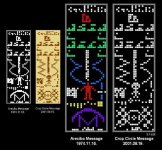DBT
Contributor
Place your bets, alien signal from Proxima or satellite?
''Now, speaking to Scientific American, the scientists behind the discovery caution there is still much work to be done, but admit the interest is justified. “It has some particular properties that caused it to pass many of our checks, and we cannot yet explain it,” says Andrew Siemion from the University of California, Berkeley.
Most curiously, it occupies a very narrow band of the radio spectrum: 982 megahertz, specifically, which is a region typically bereft of transmissions from human-made satellites and spacecraft. “We don’t know of any natural way to compress electromagnetic energy into a single bin in frequency” such as this one, Siemion says. Perhaps, he says, some as-yet-unknown exotic quirk of plasma physics could be a natural explanation for the tantalizingly concentrated radio waves. But “for the moment, the only source that we know of is technological.”
''To begin, the signal apparently varies slightly in frequency, wobbling up and down the radio dial. So it’s not coming from an antenna bolted to the ground here on Earth. That immediately makes it non-terrestrial by definition, but still doesn’t certify it as alien.
Indeed, it just might be a telemetry signal from an orbiting satellite. The orbital motion of these satellites cause their transmissions to rise and fall in frequency, after all. And while you might think that the chances of accidentally tuning in a satellite are not great, you should think again.''
Yet another participant in this lineup is the possibility that what’s been found are merely natural radio emissions from a world having a strong magnetic field. In our own solar system, Jupiter’s noisy radio bursts have been studied for many decades. Maybe there’s such a beefy, magnetically laced planet orbiting Proxima Centauri?
That may seem plausible, but if you were to transport Jupiter to the distance of Proxima, its cacophonous outbursts would be roughly a thousand times weaker than the faintest signal our radio telescopes can detect. In other words, this explanation for the detection depends on there being an extraordinarily noisy world orbiting Proxima Centauri. Not impossible, but a bit unlikely.
Of course, there’s always the possibility that the signal is really, really local. A microwave oven in the break room of the Parkes radio telescope caused considerable consternation five years ago when it produced signals that, at first, suggested that something remarkable was happening in the distant cosmos. In fact, it was just someone heating up lunch.
So, given even this short laundry list, we see that there are several possible explanations for the signal that are, regrettably, rather prosaic. Yes, as long as we still don’t know, we should continue to consider the alien hypothesis viable. After all, any SETI detection is going to be dicey when we first make it … there will be plenty of calls for restraint intended to pacify the all-too-eager. But it’s reasonable to expect that someday one of these suspicious signals will, indeed, be the sought-after proof of intelligence on another world.''
''Now, speaking to Scientific American, the scientists behind the discovery caution there is still much work to be done, but admit the interest is justified. “It has some particular properties that caused it to pass many of our checks, and we cannot yet explain it,” says Andrew Siemion from the University of California, Berkeley.
Most curiously, it occupies a very narrow band of the radio spectrum: 982 megahertz, specifically, which is a region typically bereft of transmissions from human-made satellites and spacecraft. “We don’t know of any natural way to compress electromagnetic energy into a single bin in frequency” such as this one, Siemion says. Perhaps, he says, some as-yet-unknown exotic quirk of plasma physics could be a natural explanation for the tantalizingly concentrated radio waves. But “for the moment, the only source that we know of is technological.”
''To begin, the signal apparently varies slightly in frequency, wobbling up and down the radio dial. So it’s not coming from an antenna bolted to the ground here on Earth. That immediately makes it non-terrestrial by definition, but still doesn’t certify it as alien.
Indeed, it just might be a telemetry signal from an orbiting satellite. The orbital motion of these satellites cause their transmissions to rise and fall in frequency, after all. And while you might think that the chances of accidentally tuning in a satellite are not great, you should think again.''
Yet another participant in this lineup is the possibility that what’s been found are merely natural radio emissions from a world having a strong magnetic field. In our own solar system, Jupiter’s noisy radio bursts have been studied for many decades. Maybe there’s such a beefy, magnetically laced planet orbiting Proxima Centauri?
That may seem plausible, but if you were to transport Jupiter to the distance of Proxima, its cacophonous outbursts would be roughly a thousand times weaker than the faintest signal our radio telescopes can detect. In other words, this explanation for the detection depends on there being an extraordinarily noisy world orbiting Proxima Centauri. Not impossible, but a bit unlikely.
Of course, there’s always the possibility that the signal is really, really local. A microwave oven in the break room of the Parkes radio telescope caused considerable consternation five years ago when it produced signals that, at first, suggested that something remarkable was happening in the distant cosmos. In fact, it was just someone heating up lunch.
So, given even this short laundry list, we see that there are several possible explanations for the signal that are, regrettably, rather prosaic. Yes, as long as we still don’t know, we should continue to consider the alien hypothesis viable. After all, any SETI detection is going to be dicey when we first make it … there will be plenty of calls for restraint intended to pacify the all-too-eager. But it’s reasonable to expect that someday one of these suspicious signals will, indeed, be the sought-after proof of intelligence on another world.''

